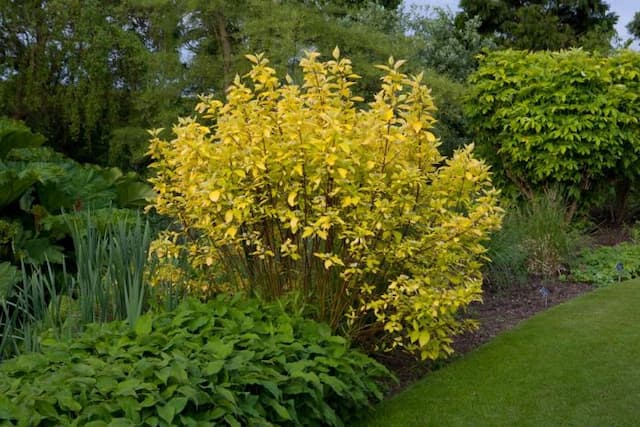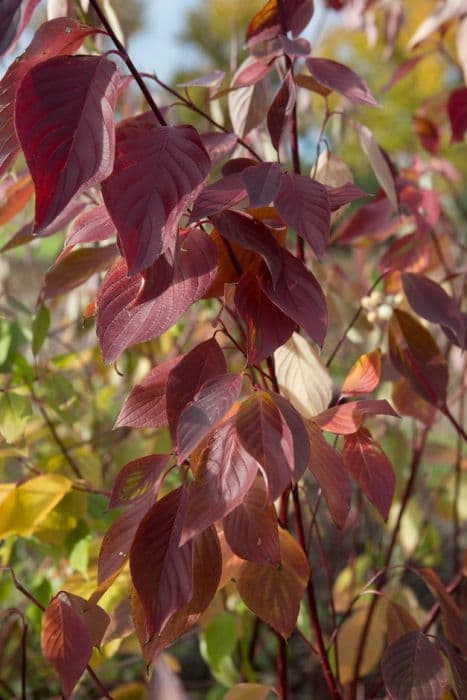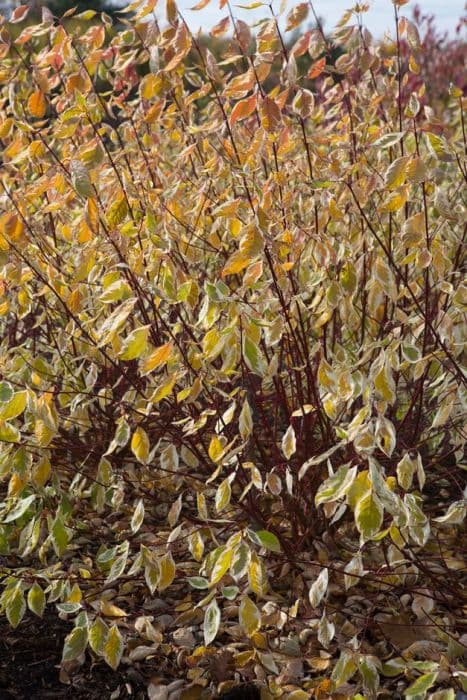Kousa Dogwood Cornus kousa 'John Slocock'











ABOUT
Cornus kousa 'John Slocock' is a variant of the Kousa dogwood, which is known for its unique ornamental appeal. This plant features a multitude of seasonal changes that captivate onlookers throughout the year. In spring, it boasts a striking floral display with star-like blooms that make it appear as though it's covered in a blanket of small, white flowers. These blooms are actually modified leaves called bracts that surround the tiny, central, greenish-yellow flowers. As the seasons progress, the foliage of 'John Slocock' transforms into a lush green canopy, creating a soothing and refreshing visual. The leaves are oval to lance-shaped with a smooth surface and pointed tips. They are arranged oppositely on the branches, giving the plant a symmetrical appearance from afar. In autumn, this Kousa dogwood presents another breathtaking show when its leaves turn to vibrant shades of red and purple, heralding the coming of cooler weather. The seasonal color transition provides a splash of warmth to the landscape. The plant also bears fruit which manifests as round, berry-like drupes. Typically, these fruits are pink to red and have a bumpy texture, adding yet another layer of visual interest. These berries are not only attractive but also serve as a food source for local wildlife, such as birds. Throughout the year, the bark of 'John Slocock' adds to its ornamental value. It is exfoliating, meaning it peels away in patches to reveal a mottled pattern of tan, gray, and brown—offering yet another intriguing characteristic that sets this plant apart in any garden setting. Cornus kousa 'John Slocock' is a delightful addition to any landscape, with its captivating flowers, seasonally changing leaves, decorative fruit, and textural bark. It embodies a blend of tranquil greens, floral whites, autumnal reds, and year-round bark patterns, making it a year-round focal point for any space it graces.
About this plant
 Names
NamesFamily
Cornaceae.
Synonyms
Kousa Dogwood, Korean Dogwood, Chinese Dogwood, Japanese Dogwood.
Common names
Cornus kousa 'John Slocock'.
 Toxicity
ToxicityTo humans
Kousa dogwood is not known to be toxic to humans. In fact, the fruit of the Kousa dogwood is edible and often consumed in some cultures for its mildly sweet flavor. There are no widespread reports of toxic reactions from ingesting parts of this plant, so it is generally considered safe for human consumption, although individual allergies and sensitivities can always occur.
To pets
Kousa dogwood is also generally recognized as safe for pets, including dogs and cats. There are no known toxic effects of this plant on pets, and it's not listed on common toxic plant databases for pets. While the fruit is not toxic, the ingestion of any plant material can potentially cause mild stomach upset for some animals, so it is always advisable to keep an eye on your pets and prevent them from consuming large amounts of any non-food plant material.
 Characteristics
CharacteristicsLife cycle
Perennials
Foliage type
Deciduous
Color of leaves
Green
Flower color
White
Height
15-20 feet (4.6-6.1 meters)
Spread
15-20 feet (4.6-6.1 meters)
Plant type
Tree
Hardiness zones
5-8
Native area
Asia
Benefits
 General Benefits
General Benefits- Ornamental Value: Cornus kousa 'John Slocock', commonly known as Kousa Dogwood, offers year-round ornamental interest with its delicate white flowers in spring, vibrant red-pink fruit in summer, and fiery foliage in the autumn.
- Disease Resistance: It is more resistant to diseases such as dogwood anthracnose and dogwood borer, which can affect some other dogwood species.
- Drought Tolerance: Once established, Kousa Dogwood has a good tolerance for drought conditions, making it relatively low maintenance in terms of watering.
- Cold Hardiness: It has a strong tolerance for cold weather, making it suitable for a range of climates.
- Pollinator Friendly: The flowers attract bees and other pollinators, contributing to the health of the local ecosystem.
- Bird Habitat: The fruit provides a food source for birds during the fall, creating a habitat for wildlife and promoting biodiversity.
- Low Canopy: This dogwood has a low canopy, making it an excellent choice for planting under power lines or in smaller garden spaces where vertical space is limited.
- Versatility: It can be used in various landscape designs, including as a specimen plant, in foundation plantings, or in mixed borders.
 Medical Properties
Medical Properties- This plant is not used for medical purposes.
 Air-purifying Qualities
Air-purifying QualitiesThis plant is not specifically known for air purifying qualities.
 Other Uses
Other Uses- Cornus kousa fruit can be fermented to create a unique, homemade wine with a distinct, tropical flavor.
- The textured bark of mature kousa dogwood trees can be used in landscape photography to add depth and interest to natural scenes.
- Leaves from the kousa dogwood can be incorporated into botanical prints and natural art for their attractive shape and vein patterns.
- Branches and twigs can be used for rustic crafts, such as wreath making, providing a charming, woodland aesthetic.
- Sliced and dried kousa dogwood fruit can be utilized as a natural sweetener or decorative topping for baked goods and desserts.
- The wood, due to its hardness and density, can be used in making small, turned objects like tool handles or decorative finials.
- Ink can be made from the bark and fruit, offering a sustainable option for artists seeking to create with organic materials.
- During spring, the flower bracts can be floated in bowls of water to create simple, elegant table centerpieces.
- Kousa dogwood can be used as a subject for scientific studies on climate adaptation due to its temperature and drought resistance.
- The tree's spreading form provides habitat structures for wildlife, such as nesting birds and beneficial insects.
Interesting Facts
 Feng Shui
Feng ShuiThe Kousa Dogwood is not used in Feng Shui practice.
 Zodiac Sign Compitability
Zodiac Sign CompitabilityThe Kousa Dogwood is not used in astrology practice.
 Plant Symbolism
Plant Symbolism- Endurance: Cornus kousa, commonly known as Kousa dogwood, often symbolizes endurance due to its hardy nature and ability to thrive in various conditions.
- Purity: The white bracts of the Kousa dogwood can represent purity and innocence.
- Christ's Passion: In Christian symbolism, the dogwood is often associated with Christ's crucifixion, with the flower's four petals symbolizing the cross.
- Resurrection: The Kousa dogwood's spring blooming is sometimes associated with the theme of resurrection due to its emergence after the cold of winter.
- Protection: Dogwoods were once believed to be able to ward off evil spirits, which translates into a symbolic meaning of protection.
 Water
WaterThe Kousa Dogwood should be watered deeply once a week, providing about 1 to 1.5 inches of water each time to soak the soil thoroughly. During hot or dry periods, increase watering frequency to twice a week. Ensure that the soil is well-draining to prevent waterlogging. For young trees, it’s important to maintain consistent moisture, but once established, they can tolerate some drought. Avoid overhead watering to keep the foliage dry and prevent the spread of diseases.
 Light
LightKousa Dogwood thrives best in a spot with full sun to partial shade conditions. At least 4 to 6 hours of direct sunlight is ideal for optimal growth and flowering. However, in particularly hot climates, providing afternoon shade can help protect the tree from excessive heat stress.
 Temperature
TemperatureKousa Dogwood prefers temperate conditions and is hardy in USDA zones 5 through 8. It can tolerate a temperature range from -20 to 85 degrees Fahrenheit but thrives best when the temperature is between 60 to 75 degrees Fahrenheit. Winter cold should not be a problem within this range, but summer heat above 85 degrees Fahrenheit can cause stress if the tree is not adequately watered.
 Pruning
PruningPrune Kousa Dogwood to shape the tree, remove dead or broken branches, and encourage healthy growth. The best time to prune is late winter or early spring before new growth starts, usually once a year. Thinning out crowded branches can help increase light penetration and air circulation, which is beneficial for the health of the tree.
 Cleaning
CleaningAs needed
 Soil
SoilThe Kousa dogwood 'John Slocock' flourishes in well-draining, fertile soil with a pH of 5.5 to 6.5. A good soil mix includes loam, peat, and a small amount of sand to aid drainage. Regularly adding organic matter will enrich the soil and support healthy growth.
 Repotting
RepottingKousa dogwoods like 'John Slocock' typically do not require frequent repotting as they are outdoor garden plants. They should only be transplanted if necessary, such as when outgrowing their current location or for specific landscaping needs.
 Humidity & Misting
Humidity & MistingKousa dogwoods, including 'John Slocock', do best in average outdoor humidity levels. They do not require any special humidity considerations and are fairly adaptable to the natural outdoor humidity in their growing zones.
 Suitable locations
Suitable locationsIndoor
Not ideal for indoors; Kousa dogwood 'John Slocock' needs outdoor environment.
Outdoor
Plant in acidic, well-draining soil; full sun to partial shade.
Hardiness zone
5-8 USDA
 Life cycle
Life cycleCornus kousa 'John Slocock', commonly known as Kousa Dogwood, begins its life cycle as a seed, which after stratification, germinates in spring. The seedling stage follows, characterized by the emergence of the first leaves and a primary root system development, which may last for a couple of seasons. As it enters the vegetative growth stage, the plant develops a sturdy trunk, branches, and a fuller canopy of leaves, along with a more extensive root system. Flowering occurs in late spring to early summer, with the Kousa Dogwood producing characteristic white to pink bracts that surround small greenish-yellow flowers, leading to pollination and fruit set. The fruits are berry-like (drupes), which turn red in late summer to fall and are enjoyed by birds. Over the years, the Kousa Dogwood matures and can reach up to 15-30 feet in height, with a broad, spreading form, before eventually entering senescence and declining with age.
 Propogation
PropogationPropogation time
Late Winter-early Spring
The Cornus kousa 'John Slocock', commonly known as Kousa dogwood, is best propagated through semi-hardwood cuttings during midsummer. To do this, select a healthy stem that is beginning to mature but still has some flexibility. Cut a section of stem about 4 to 6 inches (10 to 15 centimeters) long, ensuring it contains at least two or three leaf joints. Strip the leaves from the lower half of the cutting and dip the cut end into rooting hormone to encourage root growth. Plant the cutting in a well-drained potting mix and cover with a plastic bag to maintain humidity. Keep the soil moist but not waterlogged and wait for root development, which may take several weeks. Once rooted, the cuttings can be potted individually and eventually planted out in the garden.

![Dogwood [Baton Rouge]](/_next/image?url=https%3A%2F%2Fplants-admin.emdemapps.com%2Fimages%2Fplants%2F%2Fimages%2F604b59cf0fefd.png&w=640&q=75)


![Dogwood [Ivory Halo]](/_next/image?url=https%3A%2F%2Fplants-admin.emdemapps.com%2Fimages%2Fplants%2F%2Fimages%2F604b535cbcb9a.png&w=640&q=75)




